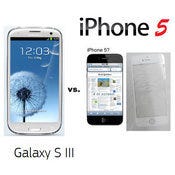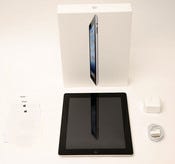Apple, Samsung Expert Witnesses Reap Big Bucks
How pretty was the pay day? Apple gave one expert witness $1.75 million to construct a damages figure in the case against Samsung.


Apple iPhone 5 Vs. Samsung Galaxy S III: What We Know
Apple iPhone 5 Vs. Samsung Galaxy S III: What We Know (click image for larger view and for slideshow)
Despite all the contradictions and complexities in the Apple vs. Samsung patent infringement trial, one thing was abundantly clear: expert witnesses, supporting one side or the other, make a lot of money.
For them, their day in court is often the result of many hours of advance preparation leading to 15 minutes of fame and a big pay day.
Many of the witnesses were professors who have specialized in the user interface or wireless communications. Others were specialists in more narrow fields, such as icon expert Susan Kare, or entrepreneurs who had built companies and made fortunes selling them to Silicon Valley companies. Tim Williams has made over $1 million each of the past two years serving as an expert witness. He's an entrepreneur who sold one wireless company to Intel, another to Qualcomm in San Diego. As a Samsung witness, he was completely at home in the courtroom and seemed to relish the difficult questions that would come with Apple's cross examination.
Williams was the witness that Apple tried to keep out of the courtroom Aug. 14, with help from an impromptu appearance by an Intel lawyer. (Samsung is an Intel competitor in cell phone baseband processors that manage wireless transmissions.) The Intel lawyer claimed Williams had violated full disclosure requirements, which meant he had a conflict of interest that might compromise Intel if he disclosed Intel source code. That's a difficult charge to pin down when it's an accepted practice in Silicon Valley for witnesses to honor non-disclosure agreements with parties they've previously done work for. Both sides eventually agreed that Williams had made no attempt to mislead the court. In the end, U.S. District Court Judge Lucy Koh seemed to agree with Samsung's Charles Verhoeven that the Intel/Apple team was trying to create a last minute disruption of the Samsung witness list.
[ Want to see how a Samsung expert witness got some final points into the trial record? See Samsung Gets In The Last Word Against Apple. ]
Williams came back a second time Aug. 17 and was put on the stand near the end of proceedings. His unexcitable, plain language was understandable by laymen, in contrast to some other expert testimony, and he undid some of the damage that had been done by a parade of Apple witnesses. Apple's Bill Lee noted to the jury that this wasn't a rare encounter between the two of them. "He's testified against Apple seven times" in the past year, he said, which might explain why Williams made over $1 million as an expert witness in both 2011 and 2010. He didn't volunteer his hourly rate.
Many of the experts were professors who came from a range of universities, on both the East and West Coasts. But they charged a surprisingly similar rate for their expertise, usually $400 to $450 an hour. No one's expertise, it seemed, was worth a mere $375 or $395. Some of them racked up hundreds of hours of work preparing for their brief appearances in the big beige federal courtroom.
Terry Musika, an expert in patent infringement damages and managing director of the Invotex Group, said he and a team financial analysts determined that Samsung's infringement damage to Apple ranged between $2.5 billion and $2.75 billion. Apple had paid him $1.75 million to come up with those figures.
Samsung attorneys pointed out that the calculation had failed to deduct any business expenses from revenues to actually determine profits, even though Apple and Samsung both have to do such calculations to submit their quarterly results. The calculations also lumped all of Samsung's products together, while Apple actually named about 20 infringing phones and two infringing tablets, not all 150 phone models that Samsung produces. These and other accounting 101 errors cast doubt on how they had arrived at their figures.
Nevertheless, when Samsung in closing pointed out how much Musika had been paid to come up with a high damage figure, Apple attorneys responded part of his fee included building a computer model with the help of additional financial analyst staff to calculate damages.
Andries van Dam, professor of computer graphics at Brown University, testified that Apple's bounce back feature was neither unique nor invented by Apple. "I have taught 'snap back' to my introductory computer graphics class for ten years," he said. That testimony was worth 460 hours of preparation at $1,000 an hour, or $460,000.
Woodward Yang, professor of electrical engineering and computer science at Harvard, testified that Apple's iPhone and iPad use technologies covered by three Samsung patents and they infringe on those patents. Yang charges $550 an hour and spent 400 hours on the case, earning $220,000. He previously earned $200,000 representing Apple in an Apple vs. Nokia case.
Susan Kare, one of the original Macintosh icon designers in 1982, also worked with Jobs at Next Computer, then left to establish her own design firm. She's done work for other computer firms, including Microsoft, and authored an authoritative text, Susan Kare Icons. She testified that Samsung's application screen on its Galaxy smart phones has some differences from the iPhone's home screen, but they are too similar for it to have happened by accident.

New iPad Teardown: Inside Apple's Tablet
New iPad Teardown: Inside Apple's Tablet (click image for larger view and for slideshow)
She pointed out key similarities and even testified she had become confused when, on a visit to an Apple attorney's office for her expert witness interview, she picked up a Galaxy on a table full of phones, thinking it was an iPhone. "I guess I became confused," she said. "Confusion" is a key word in a case with "trade dress" issues at stake. Products so similar as to produce consumer confusion is a measure of infringement of "trade dress," where a manufacturer asserts its brand-based appearance and presentation of the product has been "diluted" by copycat products.
For it to occur at the law firm, as she described, she needed to encounter a table full of phones, all of them turned on with the Galaxy models already navigated from their home screen through a series of navigational hops to the applications screen. (175 Samsung and Apple phones, most of the Samsung's, were exhibits in the trial.) That is certainly possible, but the law firm maintaining a table full of turned-on phones would need to check frequently to see which ones needed recharging. (Perhaps that's what the interns do.)
Kare's testimony was crucial, because Apple produced no surveys or cases of actual consumers who had been confused about the maker of their purchase. For her testimony, Kare charged Apple her standard consulting rate of $550 an hour, running up a total of $80,000.
Peter Bressler, principal of the Bressler Group, an industrial designer who was hired to evaluate whether certain Samsung Galaxy smart phones mimicked Apple's iPhone design and he concluded that they did. But he was caught unawares when Samsung's Charles Verhoeven pointed out that the Galaxy S 4G has corners with a different radius at the top from those at the bottom. "I haven't taken the measurement. I couldn't dispute your measurements," he responded. Verhoeven earlier had encouraged Apple designer Christopher Stringer to repeat his assertion that equally rounded corners were essential to the "beautiful" iPhone design.
Bressler insisted the Galaxy S 4G still looked like the iPhone; the three millimeter difference in radii was not significant. "In people's visual perceptions, I don't think it's quite so precise." Samsung's Charles Verhoeven shot back: "Well, details are important in design patents." It seemed an obvious thing for an industrial design expert to miss and gave Samsung the opportunity to highlight the 33% difference in a blow up chart.
Later, Bressler would admit he didn't know what elements of the design might be closely related to smartphone function (such as the location of the narrow oval used as the speaker hole on many smart phones or the four buttons at the base of a Droid phone) because he wasn't familiar with what was functional versus what was ornamental on a smartphone. "I don't believe the ordinary observer would be looking around for an opening that would be a sensor on the phone," he explained, although sensors weren't the topic of discussion.
Bressler was paid $400 an hour and had worked over 187 hours on the case, collecting $75,000 by the time he appeared in court.
Russell Winer, professor of marketing at the Stern School of Business, New York University, uses Apple as an example of successful marketing in his marketing course. He testified on Apple's trade dress, which he described as "highly distinctive … among the most distinctive in the world," and agreed it was being diluted by Samsung. He charges $625 an hour, total, $50,000.
Ravi Balakrishnan, professor of computer science and a user interface expert at the University of Toronto, charged $430 an hour and received $150,000. He buttressed Apple's claim that its bounce back feature was unique to the iPhone's and iPad's user interface. "No one had solved the desert fog problem before Apple," or the sense of being lost if a user strays off the edge of an electronic document into white space, and doesn't know in which direction to move the cursor to get back to it.
John Hauser, professor of marketing at the Sloan School of Management, MIT, testified for Apple on what its patents are worth. He estimated from an Internet survey that they add $90 in value to each iPad and $100 to the iPhone. He charges $800 an hour but had no idea what the total number of hours was. Questioned by Samsung's Charlie V. on his total bill, he said, "I'd have to ask my wife … I wish I could call my wife."
About the Author
You May Also Like






